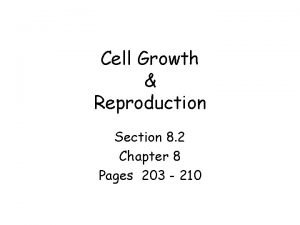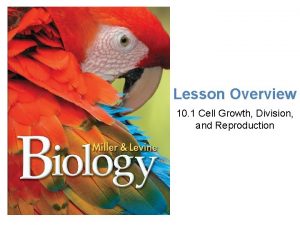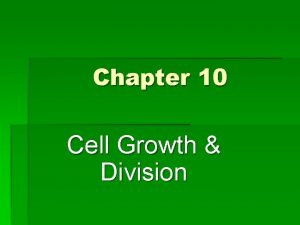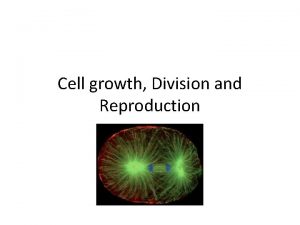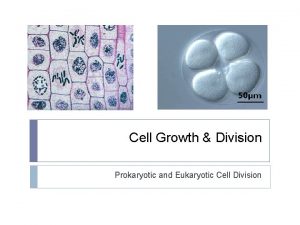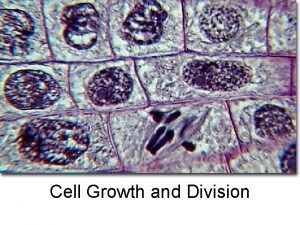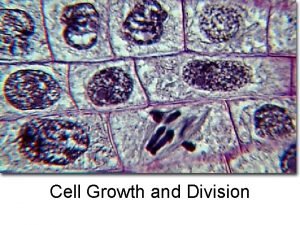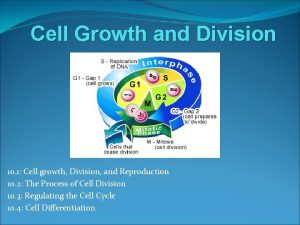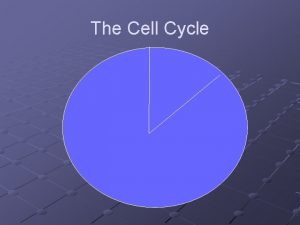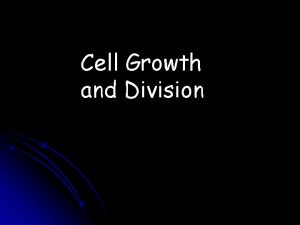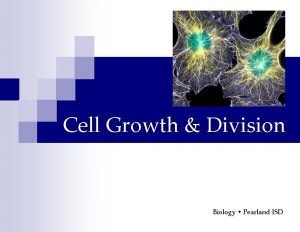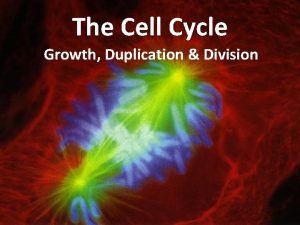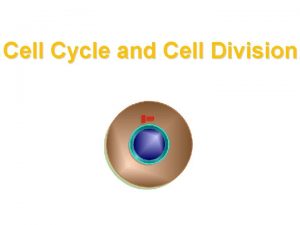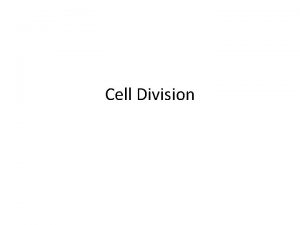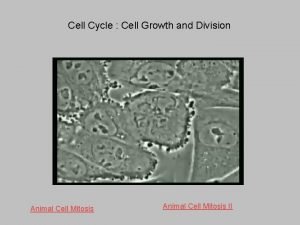Chapter 10 Cell Growth And Division I Cell




















- Slides: 20

Chapter 10 Cell Growth And Division

I. Cell Growth – – • DNA A. Limits to Cell Growth 2 reasons cells divide rather than continuing to grow indefinitely: – • – 1) larger a cell grows, the more demands on its _______ will not be making enough copies of DNA as size increases---This would cause an information crisis. 2) difficult to move waste and nutrients across cell rate @ which waste products leave cell depends on ____________ of cell=total area of cell membrane Surface area

– rate @ which food and Oxygen are used up and waste produced depends on ___________ – RATIO OF SURFACE AREA TO VOLUMEassuming a cube shape, surface area=l x w x 6…. . volume= lx w x h…. ratio = SA /volume Cell volume

Ratio of Surface Area to Volume in Cells Section 10 -1 Cell Size Surface Area (length x width x 6) Volume (length x width x height) Ratio of Surface Area to Volume

• Volume increases faster than surface area/CAUSING RATIO TO _________. . causing serious problems for cell decrease

B. Division of Cell -A cell divides into 2 daughter cells =________________ – This happens before a cell can get too large – DNA __________before cell division, solving info crisis. Cell division replicates

II. Cell Division • ***simpler in prokaryotes – A. chromosomes –carries genetic info in eukaryotes – made up of ______ and proteins – cells of every organism have a specific # of Chromosomes 46 – humans have___ Chromosomes – fruit flies have 8 – usually not visible except in cell division, when they condense – __________before cell division Replicates or copies DNA

– each Chromosome consists of 2 identical _________, which separate from each other in cell division – chromatids attached @_________, usually near middle chromatids centromere

B. Cell Cycle – ____________is in- between phase – ___________is the series of events that a cell goes through during growth and division…. Where the cell grows, prepare for division, divides into 2 daughter cells interphase Cell Cycle

– 4 phases • M= ________________ • S= ________________ • G 1 and G 2= ___________________ Mitosis and cytokinesis Chromsomes replicate & DNA synthesis, some proteins synthesize G 1=cell growth/G 2= organelles and molecules produced

Figure 10– 4 The Cell Cycle Section 10 -2 G 1 phase M phase S phase G 2 phase

ANAPHASE

1) Prophase – – – centrioles Longest phase Chromosomes become visible ____________, 2 tiny structures near nuclear envelope-separate and take positions on opposite ends of nucleus Centrosome region helps organize _________-microtubules that help separate chromosomes Chromosomes attach to _____________ @ end chromosomes coil tightly and nuclear envelope disappears spindle Spindle fibers

• 2) Metaphase • • • chromosomes line up @ center Centromeres go to 2 poles 3) Anaphase • • • Centromeres split Chromatids separate and become individual ___________ New chromosomes go to opposite poles and then stop moving chromosomes

• 4) Telophase • Chromosomes disperse into tangle of material • New nuclear envelopes • Spindle breaks apart • Nucleolus becomes visible

D. Cytokinesis-divison of cytoplasm – Usually along w/ Telophase – Cell plate forms in plants that becomes the _______________ CELL WALL

III. • ___________= disorder in which some of the body’s cells lose the ability to regulate growth • They do not respond to signals that regulate growth • Divide uncontrollably, making __________(masses of cells) • _______=protein that regulates normal cell cycle (in eukaryotes) tumors cancer cyclins

Videos • Click a hyperlink to choose a video. • Animal Cell Mitosis • Animal Cell Cytokinesis Video

Video 1 Animal Cell Mitosis • Click the image to play the video segment.

Video 2 Animal Cell Cytokinesis • Click the image to play the video segment.
 Section 8-2 cell division
Section 8-2 cell division Cell growth division and reproduction
Cell growth division and reproduction Events of the cell cycle
Events of the cell cycle Cell cycle and cell division
Cell cycle and cell division Cell cycle mitosis
Cell cycle mitosis Absolute growth rate and relative growth rate
Absolute growth rate and relative growth rate Eudicot
Eudicot Primary growth and secondary growth in plants
Primary growth and secondary growth in plants Vascular ray
Vascular ray Long division and short division
Long division and short division Short division
Short division Division of polynomials
Division of polynomials Synthetic division example
Synthetic division example Carothers equation
Carothers equation Geometric growth vs exponential growth
Geometric growth vs exponential growth Neoclassical growth theory vs. endogenous growth theory
Neoclassical growth theory vs. endogenous growth theory Organic vs inorganic growth
Organic vs inorganic growth The scientist mathias schleiden studied _______ in ______.
The scientist mathias schleiden studied _______ in ______. Mitosis meiosis
Mitosis meiosis ক্রোমাটিড কাকে বলে
ক্রোমাটিড কাকে বলে Two cells are produced
Two cells are produced
